|
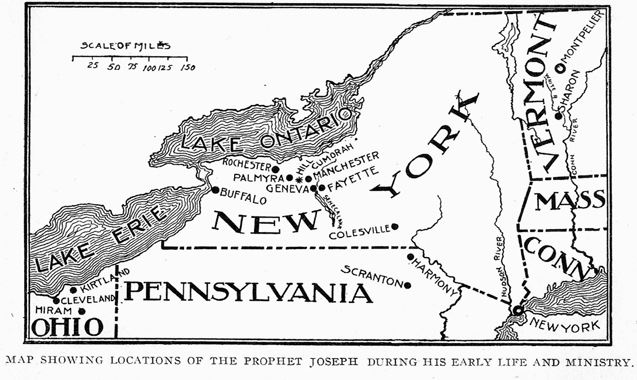
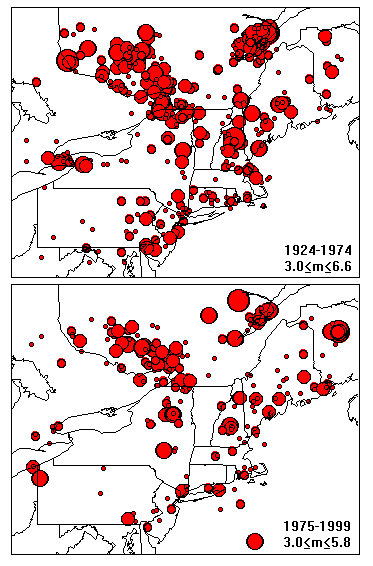
Seismic Activity in the Northeastern United States and Canada from 1924 to
1999
“And I looked and beheld the land of promise…and I saw the earth and the rocks, that they rent…and I saw the plains of the earth, that they were broken up…”
(1 Nephi 12:4)
Although seismologists have not yet found an unequivocal answer to why there are
earthquakes between the Great Lakes and the East Coast, the fact is, this region of plains, hills, mountains and inland seas is seismically active. U. S. Geological Survey data,
plotted above, shows magnitude 3.0 (smallest dot) to 6.6 (largest dot) quakes, spanning the years 1924 to 1999. A magnitude 6.0 is considered a
strong quake.
See "Why Does the Earth Quake in New England? The Science of Unexpected Earthquakes", by Alan L. Kafka, Ph.D., Weston Observatory, Department of Geology
and Geophysics, Boston College, Revised, January 3, 2004.
Snubbing the seismic facts, the following assertion recently appeared in an
article published in
Interpreter:
"One example of Bayesian “strong” evidence is the remarkable detailed description of a volcanic eruption and associated earthquakes given in 3 Nephi 8.
Mesoamerica is earthquake and volcano country, but upstate New York, where the
Book of Mormon came forth is not. If the Book of Mormon is fictional, how could
the writer of the Book of Mormon correctly describe a volcanic eruption and
earthquakes from the viewpoint of the person experiencing the event? ... We assume a
piece of evidence is “unusual” if it gives facts that very probably were not
known to the writer, someone living in upstate New York in the early 19th
century, when virtually nothing of ancient Mesoamerica was known."
("JOSEPH SMITH: THE WORLDS GREATEST GUESSER (A BAYESIAN STATISTICAL ANALYSIS OF POSITITVE AND NEGATIVE CORRESPONDENCES BETWEEN THE BOOK OF MORMON AND THE MAYA", Bruce E. Dale and Brian Dale,
Interpreter, A Journal of Latter-day Saint Faith and Scholarship, 32
(2019), 5/65)
The distinguished doctors Dale give the reader the impression that the Book of
Mormon describes in detail a volcanic eruption with associated seismic activity. Though sincere, the Dales' assertion is presumptuously false, and misleading.
Unlike
John Lloyd Stephens' 1841 bestseller, Incidents of Travel in Central America, Chiapas and Yucatán,
the Book of Mormon (1830) nowhere explicitly mentions volcanoes, or
volcanic eruptions. There are ground shakings to be sure, described in the
book, and episodes of divinely instigated cloudiness, even apart from 3
Nephi 8 (consider Mosiah 27:11,
Alma 14:26-29,
Helaman 5:23-49,
3 Nephi 18:38,
Ether 2:4-5;
14),
but no mention of a volcano, or even an indigenous description of one like
"mountain of fire".
That's a little strange, don't you think, for a literary work presumably set in
ancient Mexico or Central America?
Its true, of course, that there are no active volcanoes in
upstate New York, where the Book of Mormon came forth, where scriptural Cumorah
resides (LDS Doctrine and Covenants 128:20),
or in the broader mound builder country
of Joseph Smith's travels. "If the Book of Mormon is fictional," interject the
Dales, "how could the writer of the Book of Mormon correctly
describe a volcanic eruption and earthquakes from the viewpoint of the person
experiencing the event?"
Answer: The Book of Mormon probably does not describe a volcanic
eruption.
If not a volcanic eruption, then what is the book describing when it mentions
earthquakes followed by days
of darkness?
Lets turn to 3 Nephi 8 where we find that the "great and terrible day" began not
with rumblings, tremors, or
mention of an awakening fire mountain, but
with "a great storm, such an one as never had been known in all the land."
(3 Nephi 8:5)
There was "a great and terrible tempest; and there was terrible thunder,
insomuch that it did shake the whole earth as if it was about to divide asunder.
And there was exceedingly sharp lightnings, such as never had been known in all
the land. And the city of Zarahemla did take fire."
(3 Nephi 8:6-8)
Great inundations (reference to a "sea" can mean an inland body of water), and upheavals followed. The "quakings
of the earth" continued - some of which were the result of thunder.
There came "whirlwinds" that carried people away (tornadoes occur
most frequently in temperate North America,
including western NY). Change
and deformation of the land was attributed to tempest and whirlwind, thunder and
lightning, and finally earthquake - in that order. (3 Nephi 8:9-19)
To a lesser degree, all of these destructive agents have separately visited
western New York in recent history, including
town destroying floods.
(3 Nephi 9:7)
Then came three days of appalling darkness. There is no
explicit description of volcanic ash in the Book of Mormon. According to scripture, the two major
contributors to the daytime darkness were "smoke" (from widespread fires,
3 Nephi 10:14),
and "mists" (likely water vapor, steam, fog, blanketing cloud cover, 3 Nephi 8:22) as in New
England's historic
"Dark Day".
Joseph Smith Sr., the Prophet's father,
was eight years old, living in New England, when the Dark Day occurred. The
Prophet's New England mother, Lucy Mack Smith, was four years old at the time.
News of the 1780 Dark Day (which
occurred during the American War of Independence;
1 Nephi 13:16-19,
30)
no doubt reached other countries. We should consider the relative reference to
"foreign lands" in the prophecy of Mormon 8:29. The Dark Day and numerous
earthquakes of Olde New England
(for instance, the 1755 Cape Ann earthquake)
may be seen as having some part in the fulfillment of Book of Mormon prophecy.
(Mormon 8:29-30, consider also
1 Nephi 22:18,
Acts 2:19,
Joel 2:30,
Judges 20:40;
2 Nephi 27:2,
Isaiah 29:6)
What follows are excerpts on the topic of earthquakes and dark days,
taken from
CHOICE ABOVE ALL OTHER LANDS,
by W. V. Coon, copyright 2008, e-book edition 2011:
Comparing the
Book of Mormon with Veytia’s
History of Ancient Mesoamerica
Ancient America Rediscovered1 (hereafter abbreviated A. A. R), a translation of
Don Mariano Veytia’s Historia Antigua de Mexico, gives an account of America’s
ancient settlers who left from the Biblical Tower of Babel at the time of
the confusion of tongues. Several items of native legend detailed in
Veytia’s record, fortify ones’ testimony of the Book of Mormon and tacitly
challenge the idea that Book of Mormon lands reside in Mexico and Central
America.
No
Loss of Life!
Upon the Savior’s death, numerous earthquake fatalities occurred in Book of
Mormon lands. In the first century A.D. an earthquake shook Mexico / Central
America, but with no reported loss of human life!
Isaiah prophesied:
“Thou shalt be visited of the LORD of Hosts with thunder, and with
earthquake, and great noise, with storm and tempest, and the flame of
devouring fire.” (Isaiah 29:6 (KJV), also
2 Nephi 27:2)
We read of terrible upheavals in Book of Mormon lands:
“And it came to pass in the thirty and fourth year, in the first month
…there arose a great storm…
“…there was terrible thunder, insomuch that it did shake the whole earth as
if it were about to divide asunder.
“And there were exceedingly sharp lightnings, such as never had been known
in all the land.
“And the city of Zarahemla did take fire.
“And the city of Moroni did sink into the sea…
“And the earth was carried up upon the city of Moronihah…”
(3 Nephi 8:5-10)
According to Don Veytia a tremendous earthquake shook Central America,
presumably at the time of the Savior’s death. The natives recorded that “…an
earthquake was felt as horrible as they had ever experienced, because the
stones crashing against one another were broken into pieces, and the earth
opened up in many parts…” (A. A. R, pg
148)
The Book of Mormon speaks of “rocks” rending
(3 Nephi 10:9), and we learn
that buildings burned and or fell, crushing their inhabitants.
(3 Nephi 8:14;
10:13) Ancient peoples of
northern America used rocks and boulders in some of their constructions.
(Alma 48:8) Massive wall piles, made by
“the mound builders”, can be seen in Ohio.
(Henry Clyde Shetrone, The Mound Builders, “ARCHITECTURE AND
ENGINEERING”, Chapter III, pp 36-53)
Concerning the destruction of the wicked among his people, Nephi prophesied
that, “…buildings shall fall upon them and crush them to pieces and grind
them to powder.”
(2 Nephi 26:5, compare with
Matthew 21:42-44,
Luke 20:17-18) This does not mean that any of the
buildings Nephi saw in vision were made of hewn stone.
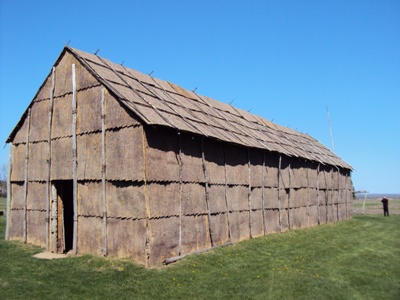
Native
American Long House - Western NY
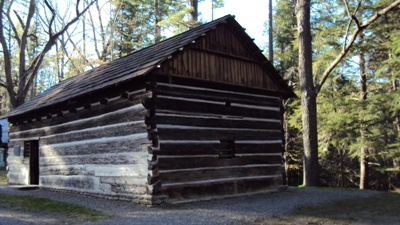
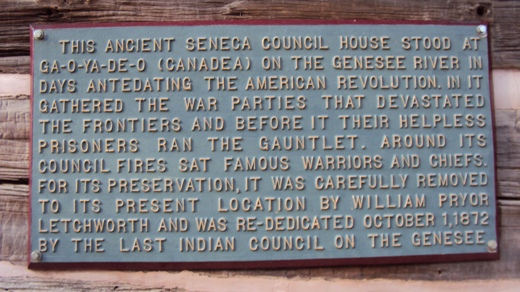
Restored Seneca Council House - Western NY
(Alma 19:18)
The Messianic
Kingdom, descending in crushing judgment, is likened to a rough, rolling
stone. (Daniel 2:34) Samuel the Lamanite
prophesied specifically of “rocks” being “broken up” and rending:
“…at the time that he shall yield up the ghost…the earth shall shake and
tremble; and the rocks which are upon the face of this earth, which are both
above the earth and beneath…shall be broken up;
“Yea they shall be rent in twain, and shall ever after be found in seams and
in cracks, and in broken fragments upon the face of the whole earth, yea,
both above the earth and beneath.”
(Helaman 14:21-22, compare with
Matthew 27:50-53)
The Lamanite prophet makes no mention of hewn stone structures tumbling to
the ground. The Book of Mormon tells us specifically that the Nephites built
“their houses, yea, their cities, and their temples, and their synagogues,
and their sanctuaries, and all manner of their buildings” out of timber.
(Helaman 3:9)
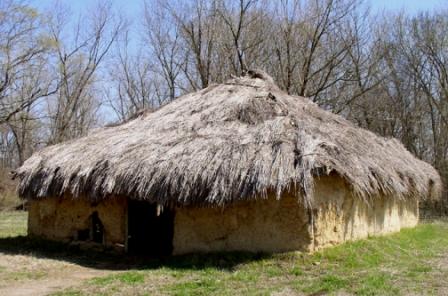
A Native
American wattle and daub, “cement” house (alternative to timber) of a type made by the mound builders of North America.
(Photo by H. Roe)
The most severe judgments came upon the covenant lands of the Book of
Mormon. Numerous wicked and unrepentant souls perished as a consequence of
the earth’s upheavals:
“And behold, that great city of Moronihah have I covered with earth, and the
inhabitants thereof, to hide their iniquities and their abominations from
before my face…
“And behold, the city of Gadiandi, and the city of Gadiomnah, and the city
of Jacob, and the city of Gimgimno, all these have I caused to be sunk, and
made hills and valleys in the places thereof; and the inhabitants thereof
have I buried up in the depths of the earth, to hide their wickedness and
abominations from before my face…”
(3 Nephi 9:5,
8)
But there was a very different outcome to the Central American earthquake:
“…Confused and bewildered they believed that the end of the third age of the
world had already arrived, which, according to the predictions of their wise
men in Huehuetlapallan, should end in strong earthquakes, in whose violence
many living people would perish, and mankind would suffer the third
calamity; but the earthquake ceasing entirely and the sun once again being
uncovered perfectly, everyone was found to be whole, without any living
person having perished, and this caused them such great wonder that they
noted it in their histories with singular care.”
(A. A. R, pg 148)
Veytia’s account parallels the venerable Ixtlilxochitl:
“…the sun and the moon eclipsed, and the earth trembled, and the rocks
broke, and many other things and signs took place, although there was no
calamity whatever toward men. This happened in the year of ce Calli, which,
adjusting this count with ours, comes to be at the same time when Christ our
Lord suffered, and they say it happened during the first days of the year.”
(Thomas Stuart Ferguson, Ancient America and
the Book of Mormon, 1957, pg 190)
Compare this account with “the great and terrible destruction” that
descended on all Book of Mormon lands. There the destruction and loss of
life was truly widespread! As terrible as the destruction was in the land
southward, “there was a more great and terrible destruction in the land
northward…”
(3 Nephi 8:11-12)
Stars Were Seen at Day
Three days of smoky, vaporous darkness covered Book of Mormon lands near the
time of the Savior’s death. No light of any kind was seen! In Mexico /
Central America, there was also an episode of darkness, but it was caused by
an eclipse of the sun, during which the day became as night, and stars could
be seen in the heavens.
As a sign of the Savior’s death, Samuel the Lamanite prophesied, “…the sun
shall be darkened and refuse to give his light; and also the moon and the
stars; and there shall be no light upon the face of this land, even from the
time that he shall suffer death, for the space of three days, to the time
that he shall rise again from the dead.”
(Helaman 14:20)
In Central America, presumably in the first century A.D. “…the sun was
eclipsed at midday, the solar body being totally covered, such that the
earth became darkened so much that the stars appeared and it seemed like
night…” (A. A. R, pg 148)
In the Promised Land of Lehi terrible lightning set forests ablaze. Whole
cities (built of timber) were “burned with fire…” The inhabitants were
destroyed, “by fire and by smoke…”
(3 Nephi 9:9-11;
10:13-14, also
2 Nephi 26:6) Mists of darkness blanketed Book
of Mormon lands. For the space of three days, “…there was not any light
seen, neither fire, nor glimmer, neither sun, nor moon, nor the stars…”
(3 Nephi 8:22)
The “vapor of smoke” that covered the face of the land is attributable, at
least in part, to the burning of woodlands and cities.
(1 Nephi 19:11;
22:18) A steamy fog may
have also contributed to the “vapor” and “mists”. The moisture content of
the fog could explain the difficulty some had kindling fire.
(1 Nephi 12:1,
4-5,
3 Nephi 8:19-23) Dry
wood taken out into a steamy atmosphere may not kindle even if the thick
mist is laden with enough oxygen to support human respiration.
A verse from the prophet Isaiah, included in the Nephite record, reminds us
that “…wickedness burneth as the fire; it shall devour the briers and
thorns, and shall kindle in the thickets of the forests, and they shall
mount up like the lifting up of smoke. Through the wrath of the Lord of
Hosts is the land darkened…” (2 Nephi 19:18-19,
Isaiah 9:18-19.
See also Mormon 8:29)
The Ancient Hebrew term translated “darkened” may mean “burned by heat”. It
may also mean “clogged in speech” or “suffocated” due to the effects of
fire. The image communicated by this interpretation of the Hebrew word is
that of a thick, choking smoke covering the land.
(עתם,
“atam”, Brown – Driver – Briggs – Gesenius
Hebrew - Aramaic Lexicon, 6272, pg 801)
It comes as no surprise that
Stephens’ Incidents of Travel in Central
America notes volcanoes. But volcanoes are no where mentioned in the
Book of Mormon. Firestorms are described, caused at least in part by
lightning. Thus we read:
“And there were exceedingly sharp lightnings, such as never had been known
in all the land.”
“And the city of Zarahemla did take fire.”
(3 Nephi 8:7-8)
Of wicked cities burned in the great destruction, the LORD said, “…I did
send down fire and destroy them…”
(3 Nephi 9:11)
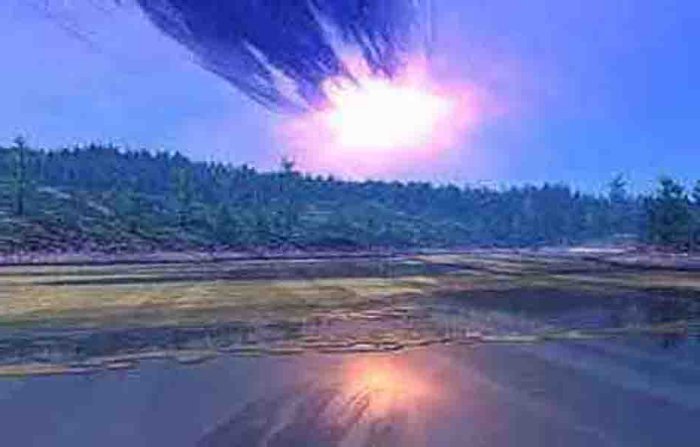
“... I would cause that fire should come down out of heaven
...”
(Helaman 13:13)
Fire from heaven could mean lightning – it could also mean something else.
Author Phyllis Carol Olive
has found a reference to a Native American legend
telling of a "blazing star" that "fell ...on the banks of the St. Lawrence,
and destroyed the people." (Olive cites
Henry R. Schoolcraft, Notes on the Iroquois, New York, 1846, pp 39-40)
A meteor or comet airburst, similar to the Tunguska Event of 1908, could in
a single stroke, account for all of the diverse modes of destruction
involved in the “great and terrible day”: fire from the sky, bright flashes
and lightning, claps of thunder and rumbling, seismic shocks and
aftershocks, strong gusts, “tempests”, "whirlwinds" (tornados), destructive
waves, brush and forest fires, clouds of smoke and water vapor. Smaller (600
ton TNT equivalent) airbursts have been recorded over the Great Lakes region
in recent history e.g. 1965, 66 and 67 and earlier.
A luminous “large
meteor” was seen hurling over western New York in Joseph Smith’s day. “Its
direction was northerly, and the explosion took place, probably, over the
lake.” It “burst” with a “report” that shook houses.
(“SPLENDID METEOR”,
Times and Seasons,
May 16, 1842, Vol. 3, No. 14, pg 784)
Gary L. Black, author of
Unsolved History, Enigmatic Events, writes on the Tunguska event:
“The effects of the explosion were felt well beyond Siberia. The Seismic
waves it generated were recorded all over Europe. The dust and smoke it sent
up caused strange atmospheric effects for days afterward. As far away as
Spain, people observed “remarkable lights” in the night sky. In London they
were so bright that, even at midnight, “it was possible to read large print
indoors.” (pg 46)
Could the night of “great lights” experience by Book of Mormon peoples at
the Messiah’s birth have something to do with dispersed atmospheric
particles from an earlier event?
(Helaman 14:3-4,
3 Nephi 1:8,
12-19; see also History of the Quichés in Stephens’
Incidents of Travel in Central America. Vol. II, pg 173)
The LORD said,”…O Israel, thou shalt not be forgotten by me. I have blotted
out, as a thick cloud, thy transgressions, and, as a cloud, thy sins: return
unto me; for I have redeemed thee.”
(Isaiah 44:21-22, KJV. See also
3 Nephi 10:5)
We are informed that the "three days of darkness" was given as a sign "more
especially" to the house of Israel inhabiting the "isles of the sea"
(1 Nephi 19:10) The Hebrew word “iim”,
translated “isles”, literally means “coasts”, “regions”, “borders”,
“habitable lands”.
(Isaiah 42:10 KJV)
It
is worth considering scriptural accounts of extraordinary obscuring clouds
that seem unrelated to volcanism.
(Helaman 5:23-49, also
Exodus 13:21-22;
14:19-20,
24;
19:9,
16,
Numbers 9:15-22,
Psalm 105:39,
Matthew 17:5,
Acts 1:9,
3 Nephi 18:38,
Mosiah 27:11,
Ether 2:4-5;
14,
Alma 14:26-29)
Tempests, tornadoes and earthquakes threaten the northeastern United States
where Cumorah resides. The God of nature is certainly able to subject the
Great Lakes region of America to three hours of cataclysm, followed by three
days of
profound darkness. It is wise to recognize other cataclysmic and sky
darkening potentials in nature besides volcanoes and volcanic ash. There
are, for instance, immense deposits of
methane on the floor of the North Atlantic. If released in sufficient quantity by earthquake or cosmic impact,
an explosive cloud of horrific potential could rise from the ocean depths. A
single lightning strike might detonate the cloud and trigger dreadful
repercussions in air, sea and land. Large swaths of shrubbery and wooded
coastline could be conflagrated suddenly.
Whatever the cause or causes of the “great and terrible day” and darkness,
there are cases of profound atmospheric darkness in places where there seem
to be no active volcanoes. Phyllis Olive is perhaps the first LDS author to
call attention to the article titled “THE DARK DAYS AND EARTHQUAKES IN
CANADA” published in
The Historical Magazine and Notes and Queries
Concerning the Antiquities, History and Biography of America
(editor
John G. Shea, New York, Vol. VIII, 1864, pp 60-65).
It is a fact that regions of Canada just to the north of New York have seen
enigmatic episodes of daytime darkness so profound and extensive that
observers, right or wrong, have attributed the phenomena to volcanism. The
Historical Magazine of 1864 cites several well documented examples and
presents the opinions of notable witnesses of the phenomena. Chief Justice
Sewell, President of the Library and Historical Society of Quebec was one
eye witness to the phenomena and investigated previous occurrences. He
surmised:
“As to the conflagration of a forest, the facts of which we are in
possession do not appear to warrant a belief that such can be the cause. It
seems impossible to suppose that the conflagration of a forest could have
produced a mass of smoke so dense and so extensive as to overspread, as it
did in October, 1785, the surface of a territory exceeding certainly 300
miles in length, and probably 200 miles in breadth, and producing at its
utmost longitudinal extremity, and at mid-day, the obscurity of the darkest
night…” (“THE DARK DAYS AND EARTHQUAKES IN
CANADA”, The Historical Magazine, pg 61)
The editor counters:
“Assuming that there existed in the great peninsula of Labrador no other
combustible material besides the stunted trees, there would be good ground
for attributing the “Dark Days of Canada” to some other agency than that of
burning vegetable matter; but when we reflect that the country is almost
everywhere covered with a thick coat of lichens and mosses where these have
not been burnt, and that they are even better adapted, when dry, to burn
with extraordinary rapidity, and afford during their combustion a greater
cloud of smoke than forest trees, it will be apparent that the precise
element for producing the phenomena of smoke and ashes existed in the
Labrador Peninsula to a remarkable degree. Dry caribou moss burns with
wonderful rapidity, as we found to our cost; it also emits dense volumes of
smoke, and leaves behind a great quantity of ash and charcoal…After having
witnessed the combustion of caribou moss on a large scale, and the
appearance of the burnt country on the borders of the great table-land of
Labrador, I am inclined to the opinion that the “Dark Days of Canada” were
the result of a vast conflagration in the interior of the Labrador
Peninsula, and that the materials which assisted most in feeding the fires
were the lichens and mosses which grow in such rich abundance and
extraordinary luxuriance and beauty in that desolate country. The
astonishing speed with which fire runs through the moss has been describes
by several writers, and there is no valid reason why a fire should not
stretch from Hudson’s Bay to the Gulf of the St. Lawrence in a few days…”
(“THE DARK DAYS AND EARTHQUAKES IN CANADA”,
The Historical Magazine, pg 63 - 65)
It is well established that western New York (including the region of
Cumorah) is prone to strong earthquakes. (See
“Why Does the Earth Quake in New England? The Science of Unexpected
Earthquakes”, by Alan L. Kafka, Ph.D., Weston Observatory, Department of
Geology and Geophysics, Boston College, Revised, January 3, 2004)
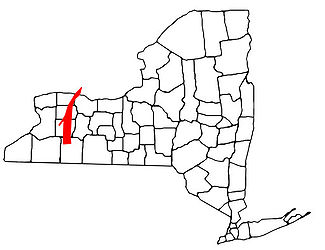 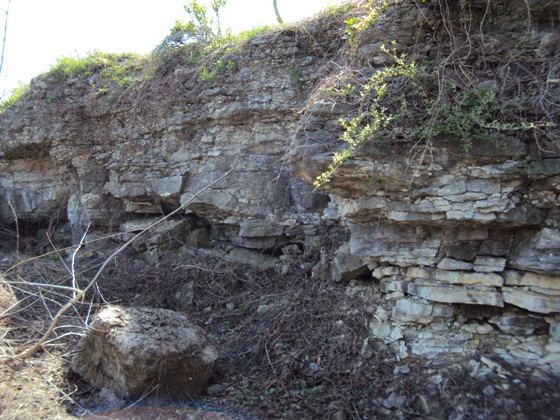
Clarendon-Linden Fault, western NY. A
portion of the
Onondaga Limestone Scarp “…found in seams and in cracks,
and in broken fragments…” along the Clarendon-Linden Fault. (Helaman 14:21-22)
The NY State Fault System extends throughout the “plains”, and hill country south of
Lake Ontario. (1 Nephi 12:4)
According to Veytia, a horrible earthquake occurred in Central America “at
the same time” as a total solar eclipse. The historian determines these
events to be at the death of Jesus Christ, which he places at 33 A.D.
The Synoptic Gospels (Matthew, Mark and Luke) tell us that during the
Savior’s crucifixion, darkness was “over the whole land” from the sixth hour
to the ninth.
(Mark 15:33) Veytia
presumes that “because of the circumstances surrounding this eclipse and
earthquake, it is impossible for it to be any other than that which was
observed at the death of Jesus Christ Our Lord…”
(A. A. R, pg 148,
Matthew 27:51,
Luke 23:44-45) Veytia seems
unaware that eclipses are local events, and that their duration is measured
in minutes.
Samuel the Lamanite’s Book of Mormon prophecy indicates that the darkness
“upon the face of this land” was a local or regional occurrence.
(Helaman 14:20,
28) The Hebrew word
“erets”
or “arets” is often translated “earth” in the King James Bible. The word can
simply mean “land”. Similar use of the word “earth” is found in the Book of
Mormon.
(Ether 13:17; see also The Collected
Works of Hugh Nibley, Volume 5, The World of the Jaredites, Ch. 2, pg
173)
Unfortunately, the translated expression “whole earth”, is often interpreted
to mean the entire planet, when the scriptural perspective is less global.
For instance, Genesis 41:56 (KJV) reads, “And the famine was over all the
face of the earth: And Joseph opened all the storehouses…” The expression
“all the face of the earth” should not be taken to mean planet wide.
(Acts 7:11) The same is true for the Book
of Mormon description: “darkness should cover the face of the whole earth
for the space of three days.”
(Helaman 14:27)
The scripture goes on to explain “that these signs and these wonders should
come to pass upon all the face of this land…”
(Helaman 14:28) The description of regional darkness in
Exodus 10:15,
21-23 is
comparable. Of course volcanic activity near the time of Christ may have had
far reaching effects. Alaska’s Mt Churchill eruption of 60 A.D. ± 200 years
was colossal. Volcanic ash has been known to travel thousands of
miles, but the intensity and duration of the darkness that visited the
coasts of Book of Mormon lands
seems to suggest more local influences.
The moon, passing in front of the sun, cannot account for the longevity of
the profound darkness described in 3 Nephi. Besides, total solar eclipses
occur when the moon is on the daytime side of the earth. Passover (when the
Savior gave up his life) always occurs near a full moon (when the moon is on
the nighttime side of the earth). A solar eclipse is then impossible.
The
NASA Catalog of Solar Eclipses
lists times and locations of eclipses
that occurred in the first century A.D. Tidal friction affecting the earth’s
rotation, is the biggest contributor to uncertainty in the estimated time of
an eclipse. Estimating back to the first century A.D. there is a margin of
uncertainty on the order of a few hours.
There was an eclipse, observable from the Middle East, on November 24, 29
A.D., another on May 20, 49 A.D. and another on April 30, 59 A.D. None of
these seem to fit very well with the expected date of the Savior’s
crucifixion, when a daytime darkness shrouded the environs of Jerusalem.
We know from scripture that the Savior laid down his life and took it up
again in the spring, in the first month of the ancient Hebrew calendar (also
the first month of the Nephite calendar) – the time of the Feast of
Passover. This was also the time when the great destruction befell the lands
of promise in America. (Helaman 14:21)
Was there a total eclipse in Central America in the first century A.D. near
this time? No. Because the moon is full near Passover, the solar eclipse
that Mesoamerica experienced could not have occurred at the time of the
Savior’s crucifixion.
There was a total eclipse on November 2, 12 A.D. that passed over Central
America, after reaching the point of maximum eclipse over South America.
There was another eclipse that passed over Nicaragua and Honduras on May 9
of the same year. In about the same region (Hondurus / Nicaragua) there was
an eclipse on Feb 26, 16 A.D. There was an eclipse around April 8, 23 A.D.,
that passed over northern Mexico. There was an eclipse on December 14, 38
A.D. that passed over the middle of Mexico and several other eclipses in
Mesoamerica between the years of 42 and 52 A.D. These of course, occurred at
times other than Jerusalem’s Passover. None of the above eclipses correlate
with events described in the Book of Mormon.
The historian Ixtlilxochitl assumes that “the first days of the year” when
“the sun and the moon eclipsed” coincided with the first month of the
ancient Hebrew calendar when the Pascal Lamb was slain. Like Veytia,
Ixtlilxochitl sees in the native account, coincidence with the Savior’s
crucifixion. The ancient Mexican month Atemoztli, however, marked a
beginning of the year which “corresponded to our month of February”.
(A. A. R, pg 82)
The legendary Mesoamerican eclipse does not match well with the three days
of darkness described in the Book of Mormon.
1 Don Mariano Fernandez de Echevarria y Veytia (1720 - 1778), Knight of
the order of Santiago, Alderman of his
country and Advocate of the Audience of Mexico is a revered Mexican
historian – native of la Puebla de los Angeles. Mariano Veytia is recognized as a
scholar of great integrity. A portion of his valuable History of Ancient
Mexico, has been translated by Ronda Cunningham, compiled by Donald
W. and W. David Hemingway, and published by Bonneville Books under the title
Ancient America Rediscovered.
Much of the history Don Veytia recorded is corroborated by the seventeenth
century Mexican historian Fernando de Alva Cortés Ixtlilxochitl (pronounced
“Easht leal sho cheet ill”).
Vincent Coon
וינסנט כון © Copyright 2019
|